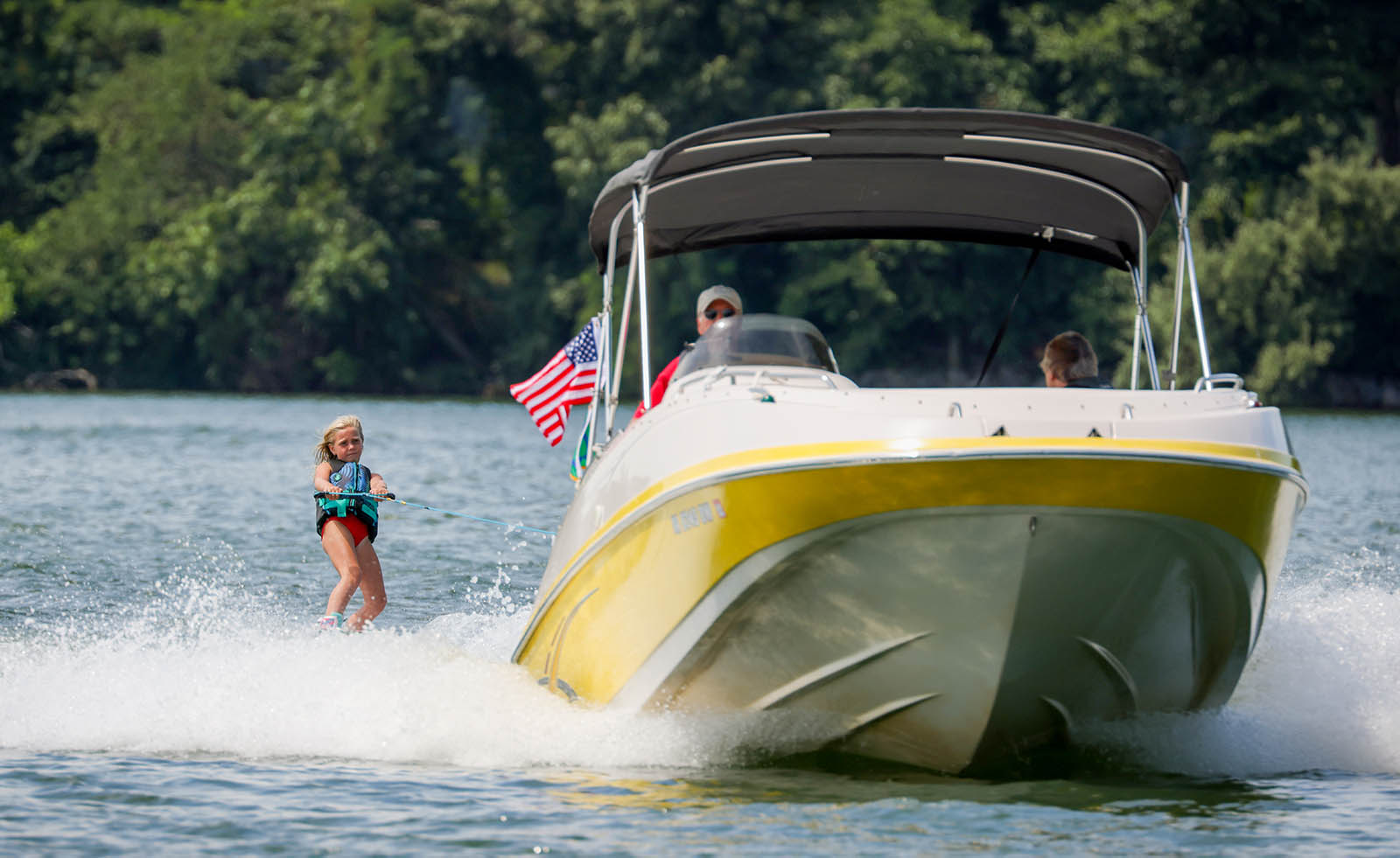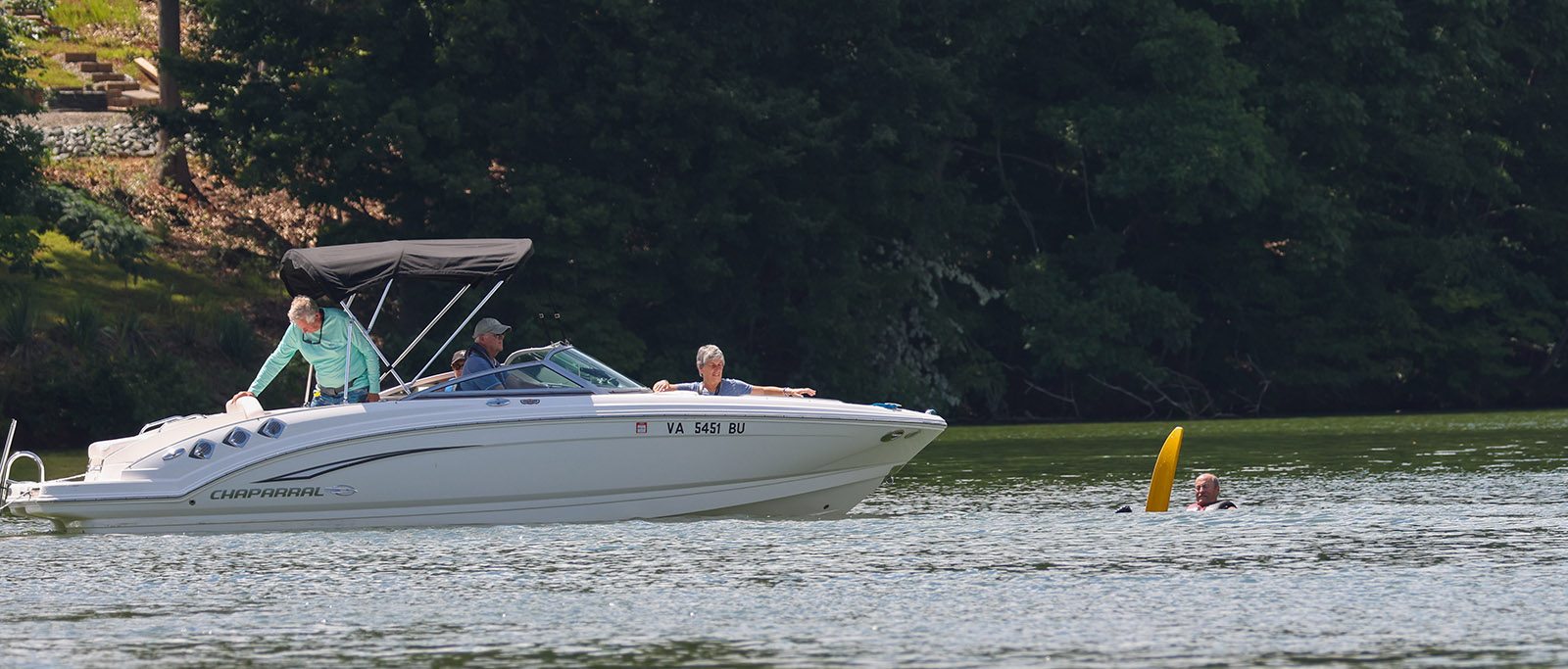By Emily Strother
Photos by Meghan Marchetti/DWR
It’s that time of year again when lakes and rivers in Virginia are buzzing with the sound of boat motors and splashing water. As many of us check our tow ropes, it’s important to remember that safety is a priority. Being prepared and knowledgeable of boating safety practices when engaging in towed water sports is every boater’s responsibility. While Virginia’s boating laws contain several provisions to ensure the utmost safety when engaging in towed water sports, it’s also important to know how to safely retrieve someone who has fallen into the water while engaging in these activities, and what can be done to avoid any potential dangers.
Ethan Coble, Recreational Boating Safety Waterways Management Specialist, Fifth Coast Guard District, says the first thing someone should do if a person is thrown overboard or falls into the water is to remain calm and yell “Man Overboard,” and always keep the person in the water within eyesight. This is the most crucial step to retrieving someone in the water.
“There should be someone on board that never takes their eyes off of the person [in the water],” said Coble.

The person on the right in the boat is keeping an eye on the rider while the boat operator focuses on what’s in the boat’s path.
Jim Emmons, Executive Director of Water Sports Foundation, Inc., also reinforces the importance of an observer on board.
“No watersports activity should be performed without an observer,” said Emmons. “There should be someone in a rear-facing seat that’s watching. The moment the towed water-sports participant falls off, that person’s job is to signal the operator that the rider is down.”
The operator should maintain at least a 15-foot distance from the person in the water on the driver’s side of the boat when circling for retrieval. The operator should have complete visibility of the person in the water.
“Everyone should be wearing a life jacket, but throw an extra floatation device toward the person in the water,” said Coble. Failure to wear a life jacket is the number one cause of death by drowning, according to the 2021 USCG Recreational Boating Statistics.
Once the operator arrives at the person in the water, the operator should immediately put the boat in neutral and shut off the engine, after which the rider should board the lower platform or use the ladder to get back onto the boat safely.

The boat operator should always be able to see the person in the water.
If the rider wishes to take another pass, the operator should circle the rider to retrieve them until the tow rope gently arrives at the hands of the rider. Once the rider is ready, make sure the tow rope is taught. The use of hand signals are the most effective way for the rider to communicate with the operator and observer to indicate when to go, stop, speed up, slow down, or maneuver in a different direction.
In approaching the person, the wind plays a critical role in effectively and safely retrieving them from the water.
“You want to approach the person from the leeward [downwind] side where the wind is hitting the boat, because you want the boat to be pushed toward the person and not vice versa,” said Coble. “You’re trying to get the boat between the wind and the person.”
Boaters can take steps to avoid falling into the water while engaging in towed water sports. Situational awareness and maintaining a safe speed when towing a rider are the most critical. A lack of proper lookout and operator inattention are among the primary causes of incidents on the water. DWR’s Navigation Rules require that every operator keep a proper lookout and maintain a safe speed.
“The operator is responsible for having a proper lookout, which means the operator should be scanning the horizon in all directions to ensure there’s nothing in the boat’s path,” said Emmons. It helps if everyone on the boat assists the operator as a lookout.
Additionally, keeping a safe distance from the engine, shallow water, the lower platform of the boat, docks, or other objects when engaging in towed water sports is important for avoiding potentially dangerous situations. Boaters should also ensure the use of proper equipment. For example, a tubing line and a wakeboard tow rope should not be used interchangeably.
In conclusion, there are four pillars to boating safety Emmons shared that every boater should abide by:
- Everyone on the boat should be wearing a USCG-approved life jacket.
- The operator should be wearing an engine cut-off switch lanyard (ECOS-L). This is critical if the driver is suddenly ejected from the boat.
- Avoid impairment.
- Get Boater Education. There are free courses.
Boaters have a responsibility to keep themselves and others safe on the water. Avoid incidents by making good decisions and follow these tips for a safe towed water-sports experience.

